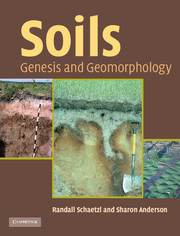Book contents
- Frontmatter
- Contents
- Preface
- Acknowledgements
- Part I The building blocks of the soil
- Part II Soil genesis: from parent material to soil
- 8 Soil parent materials
- 9 Weathering
- 10 Pedoturbation
- 11 Models and concepts of soil formation
- 12 Soil genesis and profile differentiation
- Part III Soil geomorphology
- References
- Glossary
- Index
10 - Pedoturbation
from Part II - Soil genesis: from parent material to soil
- Frontmatter
- Contents
- Preface
- Acknowledgements
- Part I The building blocks of the soil
- Part II Soil genesis: from parent material to soil
- 8 Soil parent materials
- 9 Weathering
- 10 Pedoturbation
- 11 Models and concepts of soil formation
- 12 Soil genesis and profile differentiation
- Part III Soil geomorphology
- References
- Glossary
- Index
Summary
Pedoturbation, popularized by Francis D. Hole (1961), is synonymous with soil mixing. The mechanisms and vectors by which this physical mixing is accomplished are many, and function from microscopic scales at which crystals grow and deteriorate, to larger mixing associated with uprooted trees, massive termite mounds and debris flows. The importance of pedoturbation has traditionally not been emphasized by most soil and earth scientists. Nonetheless, it is ubiquitous. Not only is it a regressive (mixing) process but it can also enhance soil genesis, horizonation and order. In short, although it is a form of mixing, pedoturbation is not, as we shall see, always synonymous with homogenization.
Pedoturbation affects soil genesis and its developmental pathways almost continually, but it often goes little noticed. Knowledge of pedoturbation is vital for the study of pre-existing stratification, such as in archeology (Wood and Johnson 1978, Rolfsen 1980, Stein 1983, Bocek 1986, McBrearty 1990, Balek 2002) and sedimentology, as well as for those who study pedogenic layering, e.g., soil scientists or geomorphologists (Johnson et al. 1987). For example, geological lithologic discontinuities can be blurred or completely masked by pedoturbation processes. Pedoturbation is in large part responsible for maintaining macroporosity in soils, which in turn aids in infiltration and retards runoff and erosion. Physical mixing of organic matter into soils is largely accomplished via pedoturbation (Fig. 12.2). In short, there is hardly a single pedogenic pathway that is not affected or altered by pedoturbation.
In order to understand pedoturbation, as with many other pedogenic processes, a starting point must be determined to analyze the effects of that process on the soil.
- Type
- Chapter
- Information
- SoilsGenesis and Geomorphology, pp. 239 - 294Publisher: Cambridge University PressPrint publication year: 2005



